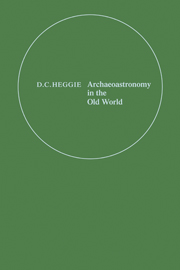Book contents
- Frontmatter
- Contents
- PREFACE
- LIST OF CONTRIBUTORS
- INVITED PAPERS
- MEGALITHIC ASTRONOMY: HIGHLIGHTS AND PROBLEMS
- ARCHAEOLOGY AND ASTRONOMY: AN ARCHAEOLOGICAL VIEW
- THE STATISTICAL APPROACH
- STATISTICAL AND PHILOSOPHICAL ARGUMENTS FOR THE ASTRONOMICAL SIGNIFICANCE OF STANDING STONES WITH A SECTION ON THE SOLAR CALENDAR
- MEGALITHIC ASTRONOMICAL SIGHTLINES: CURRENT REASSESSMENT AND FUTURE DIRECTIONS
- ASPECTS OF THE ARCHAEOASTRONOMY OF STONEHENGE
- IMPLICATIONS FOR ARCHAEOLOGY
- PI IN THE SKY
- CONTRIBUTED PAPERS
- INVITED PAPER
- INDEX
IMPLICATIONS FOR ARCHAEOLOGY
Published online by Cambridge University Press: 05 November 2011
- Frontmatter
- Contents
- PREFACE
- LIST OF CONTRIBUTORS
- INVITED PAPERS
- MEGALITHIC ASTRONOMY: HIGHLIGHTS AND PROBLEMS
- ARCHAEOLOGY AND ASTRONOMY: AN ARCHAEOLOGICAL VIEW
- THE STATISTICAL APPROACH
- STATISTICAL AND PHILOSOPHICAL ARGUMENTS FOR THE ASTRONOMICAL SIGNIFICANCE OF STANDING STONES WITH A SECTION ON THE SOLAR CALENDAR
- MEGALITHIC ASTRONOMICAL SIGHTLINES: CURRENT REASSESSMENT AND FUTURE DIRECTIONS
- ASPECTS OF THE ARCHAEOASTRONOMY OF STONEHENGE
- IMPLICATIONS FOR ARCHAEOLOGY
- PI IN THE SKY
- CONTRIBUTED PAPERS
- INVITED PAPER
- INDEX
Summary
Abstract. Some underlying aspects of the controversies concerning ‘megalithic astronomy’ in Britain are considered, including possible irrational reasons for supporting and opposing new ideas, the nature of scientific thinking in archaeology, the use of statistics and the value of the evidence of single sites. The use of ethnoastronomical studies, and the methodology of identifying alignments, are each briefly discussed as are the results of some practical tests of the astronomical hypothesis. These last suggest that the evidence for accurate prehistoric observation is weak in Wiltshire but strong in Argyll.
INTRODUCTION
For at least fifteen years a considerable controversy has flared intermittently in the field of Neolithic studies in Britain - one which concerns the fairly sophisticated astronomical functions and geometrical qualities attributed to stone circle and standing stone sites all over the country by Alexander Thom. Quite markedly differing positions have been taken up by archaeologists and by other scientists interested in the subject, and the debate shows no sign of dying down; on the contrary phrases like ‘semi-lunacy’ and ‘deluded men’ continue to be hurled by defenders of the established order (Daniel 1981, 87).
Anyone with a professional interest in this problem has three broad choices when faced with such a potentially embarrassing situation.
- Type
- Chapter
- Information
- Archaeoastronomy in the Old World , pp. 117 - 140Publisher: Cambridge University PressPrint publication year: 1982
- 2
- Cited by



